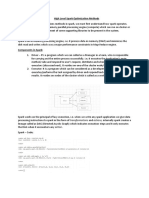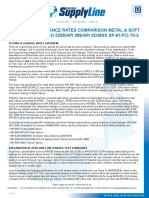0% found this document useful (0 votes)
14 views4 pagesCode Optimization in Spark
The document discusses best practices for optimizing PySpark code to enhance performance and resource utilization. Key techniques include using the DataFrame API over RDDs, caching data, efficient partitioning, avoiding UDFs, and minimizing data shuffling. Additionally, it emphasizes the importance of monitoring Spark configurations and writing efficient code for better maintainability.
Uploaded by
balakrishnaCopyright
© © All Rights Reserved
We take content rights seriously. If you suspect this is your content, claim it here.
Available Formats
Download as PDF, TXT or read online on Scribd
0% found this document useful (0 votes)
14 views4 pagesCode Optimization in Spark
The document discusses best practices for optimizing PySpark code to enhance performance and resource utilization. Key techniques include using the DataFrame API over RDDs, caching data, efficient partitioning, avoiding UDFs, and minimizing data shuffling. Additionally, it emphasizes the importance of monitoring Spark configurations and writing efficient code for better maintainability.
Uploaded by
balakrishnaCopyright
© © All Rights Reserved
We take content rights seriously. If you suspect this is your content, claim it here.
Available Formats
Download as PDF, TXT or read online on Scribd
/ 4






















































































































